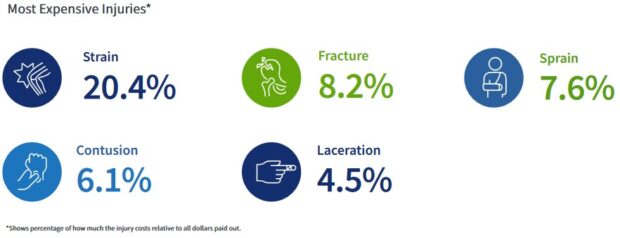A new report highlights the overall decrease in the total number of injury claims from U.S. food manufacturers post-pandemic.
Workers comp claims declined by 13 percent from pre-COVID to post-pandemic, based on AmTrust’s analysis of 15,000 claims during the period 2018-2022, outlined in its newly released 2023 Food Manufacturing Report.
“Post-pandemic has been a very volatile time for the food manufacturing industry due to labor shortages, supply chain issues and inflationary costs. In general, though, workplace injuries were down in 2020, 2021 and 2022 compared to 2019,” said Matt Zender, SVP, Workers Compensation Product Manager.
The top three injuries reported by food manufacturers in the U.S. included strains, cuts and falls. These three injuries accounted for more than 40 percent of claims relating to strains, lacerations and contusions.
Strains, according to AmTrust, a global specialty property and casualty insurer and workers compensation provider, are the most common reported injuries by food manufacturers, and also the most expensive to treat.
More than one quarter [28 percent] of all injuries were caused by strains and almost a third [31 percent] of the most expensive workers compensation claims were for strains, according to AmTrust’s claims analysis.
The most expensive cause of injuries included strains, falls (23 percent), struck by object (11 percent) and caught in between object (7.2 percent), accounting for 70 percent of all claims filed, the analysis found.
Injury to multiple body parts resulted in the biggest percentage of workers compensation claims paid. Low back injuries were the third most common injury but the second most expensive to treat.
“Food manufacturing involves various forms of manual material handling which could involve lifting and moving objects and pushing and pulling equipment – all actions that could lead to musculoskeletal disorders (MSDs) and strain/sprain injuries,” said Woody Dwyer, director of Loss Control for AmTrust and a Certified Professional Ergonomist (CPE).
“We are working with food companies who are testing occupational exoskeletons which could take the strain off the body, and we’re pleased to see the progress in that area,” Dwyer added.
Seasonal trends could be seen in the numbers, as manufacturers prep for busy holiday seasons with more staff and hours on the floor, workplace injuries increase.
The report’s release coincides with National Safety Month which began earlier this month.





















 Executive Utterances: On Presenting
Executive Utterances: On Presenting  Global Warming Likely to Push Future Hurricane Seasons to Extremes: Study
Global Warming Likely to Push Future Hurricane Seasons to Extremes: Study  Berkshire Hathaway Announces Leadership Appointments: New CEO at GEICO
Berkshire Hathaway Announces Leadership Appointments: New CEO at GEICO  What to Expect in 2026: U.S. P/C Results More Like 2024
What to Expect in 2026: U.S. P/C Results More Like 2024 